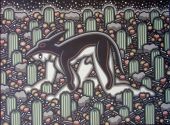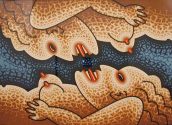“Ted Kincaid”, Art Forum
The permutations of color and image in Ted Kincaid’s photogravures raise, and politely refuse to answer, some heavy questions about modernist seriality and the identity of an individual artwork I’d be tempted to say that Kincaid’s works calculate a post-Warholian logic of pluralized identities and sameness beneath their surfaces, except that it’s nearly impossible to think that there is anything behind the ink on the paper: Like shadows, the gravures live only on the surface, which is appropriate given the light-based chemistry of the photo-intaglio process.


